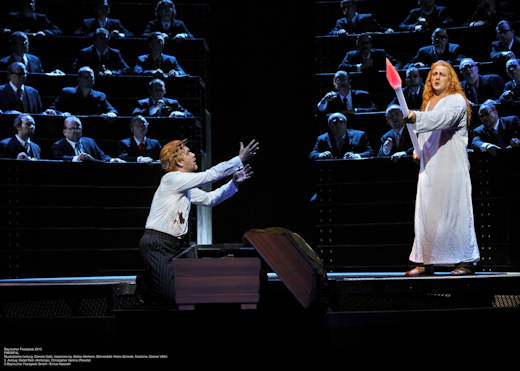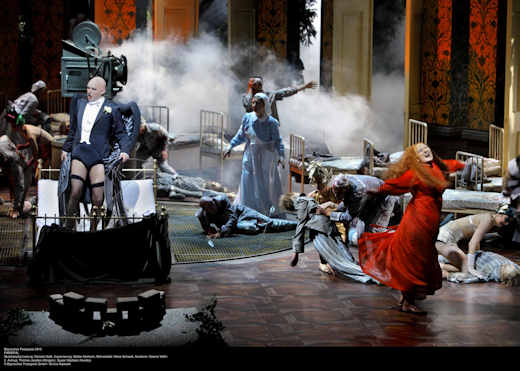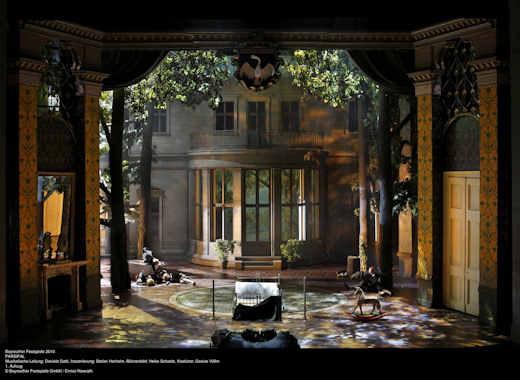Other Links
Editorial Board
- Editor - Bill Kenny
Assistant Webmaster -Stan Metzger - Founder - Len Mullenger
Google Site Search
SEEN AND HEARD
INTERNATIONAL OPERA REVIEW Bayreuth Festival 2010 (3) - Wagner, Parsifal: Soloists, chorus and orchestra of the Bayreuth Festival. Conductor: Daniele Gatti. Bayreuth Festspielhaus, 7.8.2010. (JPr)
Stefan Herheim and his dramaturg Alexander Meier-Dörzenbach along with designers Heike Scheele (sets), Gesine Völlm (costumes) and Ulrich Niepel (lighting) take Gurnemanz's line ‘zum Raum wird hier die Zeit’ almost literally. What we see often really does melt into space. Both of the first two acts are some of the most beautiful and complex things I am ever likely to ever see on an opera stage and fully reveal the wonders of Bayreuth’s technical capabilities and machinery to best effect: unlike the new Lohengrin which employs stagehands in turquoise hazard suits to move – and remove – props around from time to time. It is indescribable how subtly the scene changes take place. In Act I we begin with the Second Reich and images of the Imperial Eagle – almost every character on stage has a pair of eagle’s wings – and transmute through the almost omnipresent imagery of Wagner’s house Wahnfried to conclude with a very faithful reproduction of the original set for the Hall of the Grail from 1882.
In Act II we have reached the Germany of the Weimar Republic with its more laissez faire or liberal attitudes – think Cabaret and imagine Klingsor as a transvestite MC in a Dietrich blond wig. Later, stormtroopers of the Third Reich invade the stage, to the unfurling of Nazi banners, at Klingsor’s downfall. A large bed has also dominated what we see for most of these two acts; here a mother dies in childbirth, here Parsifal is born, various seductions take place, characters emerge or reappear and nightmares are experienced. There is also much building and rebuilding of a wall, either as toy bricks or on video, and I do not think we need puzzle long about what this repressive image means for the German people.
For those enthralled by this juxtapositioning of the Parsifal story with a century or more of the travails of German history, the final Act might seem something of a disappointment as things begin to settle down. Wahnfried is almost completely bombed-out amid the post-WWII devastation and the misery of the post-War reconstruction is depicted by the peasant women who cross the stage at one point. After having given us an overtly political rendering of Parsifal, Herheim and his team then show us – perhaps ironically - Wolfgang and Wieland Wagner’s words from the 1951 Festival, ‘Hier gilt’s der Kunst’, their request that political discussion be avoided in the post-war New Bayreuth. Finally, we are shown the modern day Bundestag in which Amfortas is at a podium making a speech. Parsifal is shown initially as King Henry the Fowler and changes to a messianic looking character in a white robe. It is not clear what ultimately becomes of him, yet as the ‘Grail’ is revealed at the end of the opera Parsifal seems to be reborn as part of a nuclear family comprising Gurnemanz and Kundry. This is from Wagner’s grave which has also been ever-present at the front of stage and is part of the action from time to time throughout the whole evening. Importantly for some, we do get to see the dove and eventually a large mirror that has reflected our – ie, the audience’s – part in Germany’s past, shows us all again to emphasise that the future is ours. I suppose that this is all about the German nation coming to terms with the past, and I felt certain that the child reborn at the end optimistically symbolises a new young united Germany in some way.

Detlef Roth (Amfortas) and Christopher Ventris (Parsifal)

Act II

The Wahnfried Set
Clearly Herheim is a director who responds to the musicality of Wagner’s score. The wonderful stage magic he gives us - at least for Acts I and II – with almost continuously shifting and imaginatively choreographed imagery seems to arise organically from the very music we are hearing. However he is not quite respectful enough to let much of the music speak for itself sometimes. When Gurnemanz sings in his Narration ‘Der Speer ist nun in Klingsor’s Hand’ we do not need to see Klingsor and the King Henry the Fowler-type character fighting it out. This is just one example among many where something needs to be seen happening apparently hust for the sake of it and amid a lot that is great about this staging, there is also some slightly dubious stagecraft now and again. Parsifal’s double leaps down onto a bed amongst the 1920s’ showgirl flowermaidens and Christopher Ventris is out of breath when he starts to sing as he swaps over with him in this botched stunt. The blackout employed to reclaim the spear from a brown-shirted Nazi youth is also dire. But then again, many moments like the large Nazi ‘Reichsadler’ (Eagle symbol) crashing down onto the stage at the end of Act II - are no less than true coups de théâtre.
Unlike the 2008 performance that I saw, this time I was convinced that Daniele Gatti had the total measure of Parsifal’s spiritual journey and was not so straight-jacketed by timing what he was doing with the action on stage. His account often had an inner glow in fact, a calm serenity and radiance somewhat at odds with the angst that Herheim gives us to look at … it would take a young Boulez to overcome that! The faultless orchestra and amazing chorus were as magnificent as could be expected.
Most of the cast sang well and suited Herheim’s production; Detlef Roth’s Christ-like Amfortas underplays the anguish a little and Thomas Jesatko’s Klingsor, however deviant he is, lacks real malevolence. Susan Maclean is miscast as Kundry. Admittedly, she has the arduous task of appearing in multiple ‘roles’ in the first two acts; she is Herzeleide, a maidservant, a seductress and is even dressed up as Klingsor at one point. She performs all of these well but is let down by her singing. I thought that this was going to be an interesting approach devoid of too many histrionic moans and shrieks which would give her ‘Ihn … und … lachte!’ - as she derides Christ on the Cross - maximum impact, but regrettably Ms Maclean does not have the secure high register to bring maximum expressiveness to her role. Kwangchul Youn sings wonderfully but does not have the presence - or gravitas - of a truly great Gurnemanz, but then again with so much going one around him whilst he is singing, he doesn’t need that so much in this staging. Christopher Ventris - another Brit doing well at the Bayreuth Festival - is an eloquent, secure and tireless Parsifal, singing with a generally radiant timbre. He acts with commitment throughout, though I hope he will not mind me remarking that he is not the most agile stage animal and looks a bit awkward at times as the overgrown schoolboy in a sailor suit during Acts I and II.
When I first reviewed Stefan Herheim’s production of Parsifal in its first year, I reported on ‘high expectations that, sadly, remained unfulfilled’ and this still remains my opinion on a second viewing this time. I had hoped that such a cinematic and visually compelling production, with its many deeply layered textures, would give me greater enlightenment on a second viewing, but this was not to be. I don’t think I am alone in this from the comments I heard throughout the evening; people admire the wonders unfolding in front of their eyes without entirely understanding what they are supposed to be telling us about Parsifal. At the end of Act I, Gurnemanz asks Parsifal ‘Weisst du, was du sahst?’ The ‘reine Tor’ in his ignorance is struck dumb by what he has witnessed and this may be the experience of many members of the audience, however rapturously the staging seems to be received.
Jim Pritchard
Pictures © Bayreuther Festspiele GmbH / Enrico Nawrath